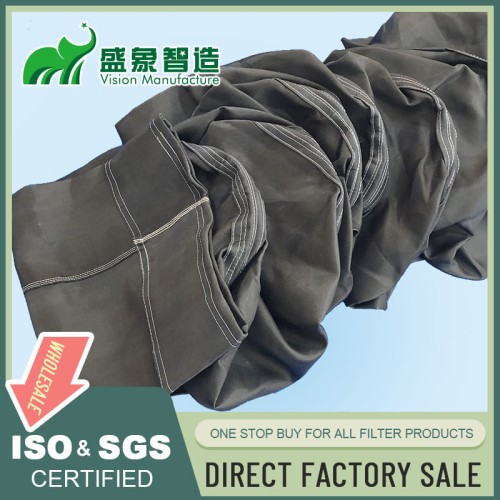
Fiberglass Dust Collector Bags: High-Performance Filtration for Extreme Industrial Environments
I. Introduction
In industrial environments where high temperatures and corrosive materials are common, effective dust collection is crucial. Fiberglass, known for its resilience under extreme conditions, serves as an ideal material for such applications. This introduction explores the challenges of high-temperature dust collection, the role of fiberglass as a filtration material, and the importance of fiberglass dust collector bags in maintaining clean, safe industrial environments.
II. Understanding Fiberglass Dust Collector Bags
Fiberglass dust collector bags are crafted from finely woven or felted glass fibers, offering high durability and resistance to harsh conditions:
- Composition and Structure: Fiberglass is made from numerous tiny glass fibers woven or bonded together, providing a robust structure that withstands high temperatures and chemical exposure.
- Manufacturing Process: These bags are typically produced through a process that involves the manipulation of glass into fibers, followed by a matting process to create a dense, yet permeable fabric.
- Types of Fiberglass Bags: Including woven, needle-felt, and membrane-coated, each offering distinct benefits depending on the specific industrial application.
III. Key Properties of Fiberglass Dust Collector Bags
Fiberglass bags are chosen for their:
- Exceptional Heat Resistance: Capable of operating in environments with temperatures up to 260°C continuously, with surges up to 280°C.
- Chemical Inertness: Resists a wide range of acids and alkalis, making it suitable for chemical processing environments.
- High Tensile Strength: Ensures durability and resistance to physical stresses.
- Dimensional Stability: Maintains shape and size under thermal stress.
- Excellent Filtration Efficiency: Effectively captures fine particulates, ensuring clean air output.
- Long Service Life: Reduces the frequency of replacement due to its durable nature.
IV. Applications in Industrial Dust Collection
Fiberglass dust collector bags are used in various high-temperature industrial processes:
- Cement and Lime Production: Handles the high-temperature gases emitted from kilns.
- Steel and Metal Processing: Captures fumes and particulates from smelting and forging operations.
- Power Generation Plants: Filters out particulates from combustion processes.
- Waste Incineration Facilities: Manages emissions from the burning of industrial and municipal waste.
- Glass Manufacturing: Essential for controlling emissions in glass furnace operations.
- Other High-Temperature Industrial Processes: Suitable for any industry where heat and particulates are a concern.
V. Advantages of Fiberglass Dust Collector Bags
The benefits of using fiberglass in filtration include:
- Superior Performance in Extreme Temperatures: Maintains integrity and functionality in harsh thermal environments.
- Resistance to Chemical Attack: Ensures longevity even in corrosive settings.
- Consistent Filtration Efficiency Over Time: Provides reliable performance throughout its service life.
- Reduced Maintenance and Replacement Frequency: Lowers operational costs and downtime.
- Compliance with Stringent Emission Standards: Helps facilities meet environmental regulations.
VI. Limitations and Considerations
While highly effective, fiberglass dust collector bags have some limitations:
- Higher Initial Cost: More expensive than some other materials.
- Brittleness and Handling Challenges: Requires careful handling to prevent damage.
- Potential Health Concerns: Fiberglass fibers can be an irritant; proper safety measures are necessary during handling.
- Moisture Sensitivity: Performance can be affected in very humid conditions.
VII. Selecting the Right Fiberglass Dust Collector Bag
Choosing the appropriate fiberglass bag involves:
- Factors to Consider: Temperature range, chemical environment, and particle size.
- Sizing and Design Considerations: Ensure a proper fit for optimal performance.
- Surface Treatments and Finishes: Enhance functionality and lifespan.
- Vision Filter's Approach: Tailored solutions that meet specific operational demands.
VIII. Installation and Maintenance
Effective installation and maintenance are crucial for maximizing the life and performance of fiberglass bags:
- Proper Installation Techniques: Ensures optimal fit and function.
- Safety Precautions: Necessary to protect workers from fiberglass irritants.
- Cleaning and Inspection Procedures: Regular maintenance helps prolong bag life and maintain efficiency.
- Troubleshooting Common Issues: Addresses potential problems before they lead to system failure.
IX. Comparing Fiberglass Bags to Other High-Temperature Options
Fiberglass bags are often compared to other high-temperature filtration materials:
- Fiberglass vs. PTFE-coated Bags: Fiberglass offers better cost-effectiveness, while PTFE provides superior chemical resistance.
- Fiberglass vs. Aramid (Nomex) Bags: Aramid offers better dimensional stability but at a higher cost.
- Cost and Performance Comparisons: Fiberglass often presents a balanced option in terms of performance and expense.
X. Environmental and Regulatory Compliance
Fiberglass dust collector bags help facilities meet strict environmental standards:
- Meeting Emission Standards: Essential for compliance with local and international regulations.
- Disposal and Recycling Considerations: Fiberglass requires specific disposal methods due to its composition.
- Workplace Safety Regulations: Ensuring safe handling and installation practices to protect workers.
XI. Innovations in Fiberglass Dust Collector Bag Technology
Advancements in technology continue to enhance the performance of fiberglass bags:
- Advanced Surface Treatments: Improve dust release and cleanability.
- Hybrid Designs: Incorporate other materials for enhanced properties.
- Improved Manufacturing Techniques: Increase efficiency and reduce waste.
- Vision Filter's Contributions: Leading the development of innovative fiberglass solutions.
XII. Case Studies: Fiberglass Bags in Action
Real-world applications demonstrate the effectiveness of fiberglass bags in challenging environments, showcasing their ability to solve complex filtration problems and deliver significant improvements in performance and compliance.
XIII. Future Trends in High-Temperature Dust Collection
The future of high-temperature dust collection sees potential advancements in fiberglass technology and its applications:
- Emerging Applications: New industries requiring high-temperature filtration solutions.
- Potential Advancements in Fiberglass Technology: Innovations that enhance performance and environmental compatibility.
- Integration with Smart Monitoring and Predictive Maintenance Systems: Improving efficiency and predictive capabilities in dust collection.
XIV. Conclusion
Fiberglass dust collector bags continue to be a vital component in managing emissions in high-temperature industrial environments. Their ability to withstand extreme conditions while providing reliable filtration makes them indispensable in modern industry. Vision Filter remains committed to advancing fiberglass technology, offering expert consultation and tailored solutions to meet the evolving needs of the filtration industry.
Leave a comment

